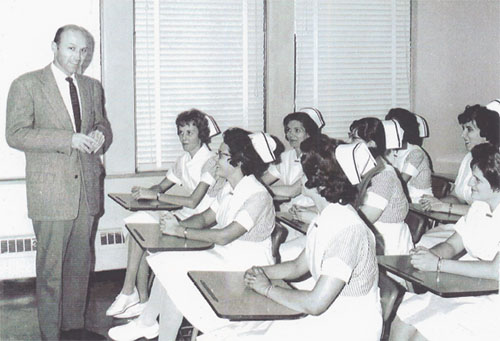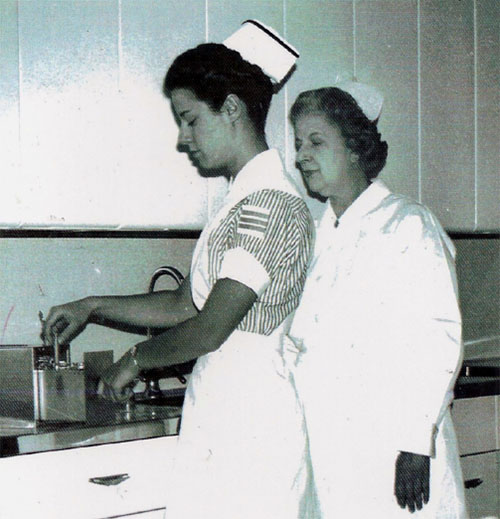"...To advance the standing and best interests of trained nurses and place the profession of nursing on the highest plane attainable..." (Constitution of the Alumnae Association of the Chester County Hospital Training School for Nurses, January 11, 1905)
In 1905. Theodore Roosevelt was president of the United States. The 19th Amendment, Women’s Right to Vote was still 15 years from the U.S. Constitution. The Industrial Workers of the World International Labor Union (IWW) was founded in Chicago. The IWW opened its membership to any wage earner regardless of occupation, race, creed or gender. It was at this time an alumnae association for the graduate nurses of The Chester County Hospital was formed.
Many stories, short and long, have been told and written about the hospital and its school of nursing. On the eve of the 115th anniversary of the Nursing Alumnae Association, we record another story, short, about the association itself. Our story is dedicated to the founders and the keepers of the association.
As Marguerite Harrar wrote in her May 1951 document, Reminiscing, "It all started back in 1880...in the small and distinguished town of West Chester, PA." Harrar’s story is about the hospital, the nurses' caps and uniforms and "the advantage of belonging to the alumnae association" for the nurses and the hospital.
Hospital
As is well documented, The Chester County Hospital opened its doors in March 1893, as a 10-bed dispensary. The first medical patient, Mr. Fred Stanley was admitted on March 1, 1893 with a diagnosis of sciatic rheumatism. The first surgical patient was Mr. Benjamin Bush, admitted on March 4, 1893 with a diagnosis of bilateral lower extremity fractures. The hospital quickly expanded, adding wards for men and women in 1895, and later a Children’s Ward, Maternity Ward and a Contagious Ward. The Hospital’s expansion has continued until the present day.
 Chester County Hospital - Circa 1925
Chester County Hospital - Circa 1925
School of Nursing
For convenience and better patient care, the Hospital Board of Managers agreed that a school of nursing was needed. The training school for nurses opened on April 1, 1894 as a two-year course. Of five students enrolled, two, who had formerly been employed by the hospital as helpers were able to graduate in one year. Miss Lily Horth and Miss Nellie Schwaderer graduated in 1896, after one year in the program due to their previous employment. The remaining three students, Miss Sara Law, Miss Margaret Stevenson and Miss Carrie Griffith graduated in 1896. Miss Horth became one of the first private-duty nurses. She also served for 12 years as a member of the Nurses’ Training School Committee. The Nurses' Training School grew. and, in 1899, the course was expanded to three years.
 Dr. Morton with the Class of 1964
Dr. Morton with the Class of 1964
Nursing Alumnae Association
A significant motivator for the Nursing Alumnae Association was Dr. John A. Farrell, a member of the medical staff, who also helped to develop the constitution and by-laws. Miss Lily Horth, with Dr. Farrell’s help, and with support from Miss Julie King, superintendent and head nurse, formed the Alumni Association of The Chester County Hospital Training School for Nurses. The first president was Abbie Miller, Vice President, Emma Weiderhold. The first Alumni Secretary was Nellie Schwaderer and Treasurer, Carrie Griffith.
As documented by Harrar, joining the hospital Alumnae Association automatically enrolled participants in the District Nursing Association, which at the time included Bucks, Chester, Delaware, Lancaster, Montgomery and Philadelphia counties. Participants also automatically became members of the Pennsylvania Nurses Association (PNA), and National Associations (ANA). Harrar discussed Association dues as "...money well spent, for...we cannot go our way alone." Advancement in nursing can only be accomplished by working together through these organizations.
The Association fostered a spirit of unity among graduates by promoting the role of the graduate nurse and by keeping the alumni informed about activities of the nursing school and its graduates. The Association also took an active interest in the student nurses by honoring the new graduates and acknowledging student achievements. Books and magazines were purchased for the nursing residence and nursing library. The Association entertained senior classes to special teas, a graduation dinner, shows and musicals. In 1994, the Association helped to celebrate the 100th anniversary of the School.
In the early 1980s the association began to lose membership. Election of officers was replaced by volunteerism. The closing of the School of Nursing further impaired growth of the Association. Revitalization attempts failed and in June of 2000, the quarterly regular meetings of the general membership were discontinued. It was agreed that the by-laws would no longer be revised. Funding projects were discontinued as well. Notable volunteer officers of the Association during this period are Anna Mae (March) Miller, Class of 1942 and Helen (Windle) Satterthwait, Class of 1949. Their efforts, along with many others, prevented the Association from disbanding.
Today, twenty years after the closing of the School of Nursing and on the eve of our 115th anniversary, the Association has reached a new stability. The focus is on its members. The organization maintains The Jean M. Oakes Rose Garden, located on the hospital grounds. Technological advances have allowed the organization to reach alumni through their webpage and social media. A new Alumni Association webpage keeps alumni informed. The idea of a School of Nursing museum at the hospital is being evaluated. It may become a reality after the current hospital construction is completed. The annual luncheon continues to be held the first Saturday in June in celebration of the 50th anniversary class and fellow alumni.
 Miss Willdonger and a student from the Class of 1964
Miss Willdonger and a student from the Class of 1964
Notes
"There is no profession which demands of its members greater purity of character and a higher standard of moral excellence than does nursing..." (Code of Ethics)
Examples of the original Constitution and Code of Ethics demonstrate that nursing has historically been the caring profession. Nursing students learned and continue to learn the principles of the art and science of nursing.
The first books of the secretary’s minutes includes the time from 1905 to 1934. There are no secretarial recordings of the period between 1937 and 1945. Whether this was related to World War II is unknown. It is known that many of the hospital’s nurses served during World War II. Nursing students replaced them in the hospital when graduate nurses volunteered and enlisted to serve the country. During this time the Hospital experienced its first nursing shortage. As nurses returned from the War to resume their duties in the Hospital however, it became difficult for those who had replaced them to find jobs.
"Miss O’Halloran encouraged nurses to take up Public Health work after graduating…to do private-duty work for two or three years before taking up the Public Health work. She outlined the different branches of the work: school, individual, community and any number of callings with great possibilities for forging ahead and advancing in the work. But she explained that all were not fitted for this work as it takes a person of pleasing personality and one who is indefatigable and not easily discouraged..." (Minutes from November 25, 1927).